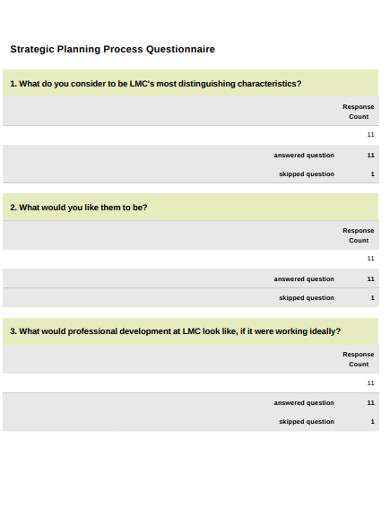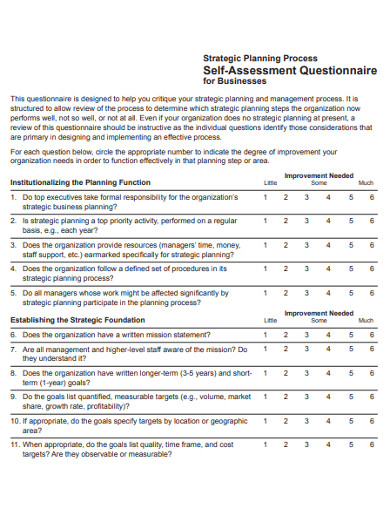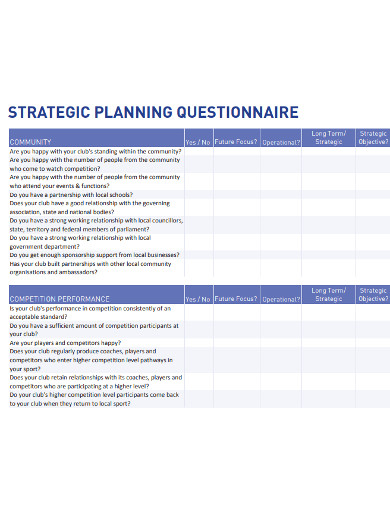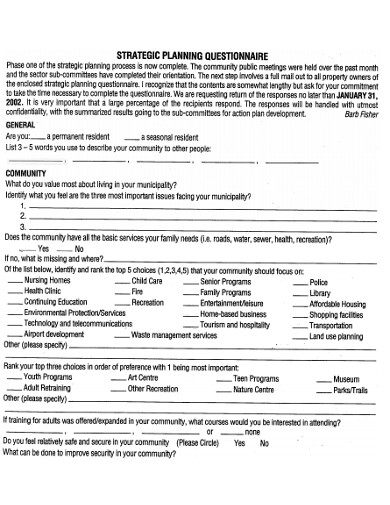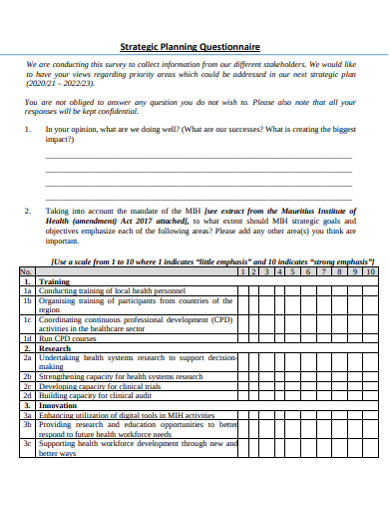Strategic Planning Questionnaire Examples
Flashback decades ago, consumer behavior was an open book. People needed an item, a company supplies them with so. The competition dangled a better bargain, and another company rivaled the offer with a more appealing deal. The old buy-more-for-less hook successfully fished our wallets until offering more value for less cost became a classic business strategy staple. The times were simpler. Until it wasn’t. Technology, globalization, and social feedback loops changed the game, although some businesses were marked safe from the disruption. The glory of one-size-fits-all strategic planning faded in these turbulent times.
Strategic planning involves setting a clear and realistic direction for your business to move towards, accounting for costs, benefits, and risks. You need questionnaires to gather relevant information for planning as you brainstorm with your team. In those meetings, you cover the bases for your project: You define your goals, set your priorities, budget your resources, dedicate an action plan, and prepare for your project evaluation. Using strategic planning questionnaires is a safe and recommended method to meet your objectives. The strategies you glean by using the data from questionnaires can get your business en route to raking in profit.
Two Sides of the Business World
Today, it’s not enough to play by the book. Business plans and strategy that was formed some years ago may not apply today. The business climate with an emphasis on change has made things a little more complicated. We can almost divide businesses into two paradigms. As mentioned, there are industries that aren’t as affected by disruptions. These sectors are generally built around commodities—electricity, water, and fresh produce are products that do not bend with the fluctuating market. That is not to say that these industries are stagnant. An eco-conscious society is calling for a shift to greener energy source alternatives, and abandoning non-renewable fossil fuels. The water service industry also has its hands full with the demands of the government and consumers, as well as the challenges brought by pollution and global warming. Meanwhile, fresh produce, like fruits and vegetables, are in a pickle because people demand bigger, better, and more vibrant products that aren’t touched by science. Even then, these changes don’t curb the demand for the mentioned products and services.
Other businesses aren’t as lucky. Since the first iPhone release in 2007, the world hasn’t looked back. The pre-iPhone era of the phone market was a glorious mélange of cellphones that looked like they went to a Halloween costume party. Today, smartphones follow a formula: smaller and smaller screen-to-body ratio and a war against buttons. In general, humans search for constancy in the fleeting nature of reality, so the deviation wasn’t because the customers demanded something new. But Apple, in this sense, disrupted the phone industry with innovative ideas and forward-thinking. And it stuck. In this paradigm, bold ideas and experiments are a profitable asset for these businesses. If the pursuit fails, either you open a new world of bankable possibilities or you become an example of an experiment-gone-wrong-and-what-to-do-instead. The industry is unpredictable. Your big idea can either be a hit or a flop: Success may as well be a case of the right place and the right time.
Modern Strategy Planning
How do businesses formulate strategies and plans when the cards seem to be stacked against them? The turbulence of the market doesn’t discredit the influence of strategic planning in the success of a business. Rather, it is a call for people in this paradigm to let go of the old ways of strategizing. Don’t match the dynamism of the market with rigidity.
Your company strategic plan, therefore, should be responsive to the fluidity of the market. Be innovative. Don’t conform to a one-size-fits-all strategy. There is more than one way to look at consumer behavior. Because no one holds the key to what will happen after a year or so, you can take advantage of this. When the product or service is a hit, you can do the necessary modifications to bring this change on a wider scale. For example, in the quest for the biggest screen possible in a smartphone, the generic notch design on the phones today was popularized by Apple when the company released iPhone X in 2017. The design was divisive among smartphone users. Today, every other smartphone is sporting the notch. The point is, the way to get ahead of the game seems to be to introduce something new, instead of following a trend.
5+ Strategic Planning Questionnaire Examples & Templates
When you know your company’s position in the market and the market itself, you won’t be left guessing what would work and what wouldn’t. By using strategic planning questionnaires, you have the information you need to strategize. Get ahead of the game with the following strategic planning questionnaire templates and examples.
1. Strategic Planning Process Questionnaire Example
2. Strategic Planning Self-Assessment Questionnaire Example
3. Sample Strategic Planing Questionnaire Example
4. Printable Strategic Planning Questionnaire Example
5. Simple Strategic Planning Questionnaire Example
Planning Your Strategy
Even when the business scene is unpredictable, you and your business should be armed to adapt to changes. Remember that strategic planning will not yield a 100 percent success rate. Your plan should be attuned to the changing environment. What should you keep in mind when preparing your brand strategic plan?
1. Specify Your Destination
You should have an idea about the direction you want to steer your business towards. Have a firm understanding of your brand and take to heart your company’s mission and vision. Subsequent decisions will always go back to what your brand stands for. These decisions should preserve and uphold the ideals of your company. When you don’t have a clear idea of what your company is about, you will tend to wander anywhere and everywhere for projects. For example, you are marketing strategy is focused on selling umbrellas today, but tomorrow you decide to launch fresh produce. Unless you are a grocery store, you have no business being distracted like that.
2. Cover and Reinforce Your Bases
Conduct a SWOT analysis of your company. Examine the vulnerability of your business. When you know the areas that might cause the business to topple should a large event in the market shakes it, you can look at ways to reinforce these parts before it’s too late. When you have an idea about where your business is leading the game, you might want to consider looking for means to bank on this success. What made that part of the company succeed when other parts suffered? Can you improve on this further to maximize its potential? You should also look at the gaps in the market that haven’t been realized yet by others. You could develop on the missing link and find something that clicks with the consumers.
3. Complacency Antagonizes Innovation
Strategies don’t always work out. They might work, they might not. Having a single strategic plan outline for your business doesn’t make you invincible in the turbulent market. It is a big mistake to be comfortable when you feel like you have done enough to be ahead of the competition for a while. Keep innovating, keep leading the change. Keep looking for something to improve on in your craft. Even if it’s not broken, your competitors might find an idea that will make your product obsolete. Keep pace with technology and the dynamism of your market. Don’t be afraid to get creative!
4. Learn from Other Companies
If you want to be successful like the big brands, look at how these companies made it on their own. For example, you can listen to how famous brands market their products successfully? What were their challenges and how did they come out on top? Don’t just focus on the success stories. Avoid pitfalls that other companies fell for by learning about how they made the mistake. Consider looking at innovative brands that are dominating the game because they didn’t let the norm contain what they are capable of.
Your company is in a turbulent environment. A change can offset the direction of the industry to one company’s favor. Play around with ideas, and if the conditions are right, you might catalyze another shift in the market. This time, you are influencing and leading the change, instead of trying to predict everything.



